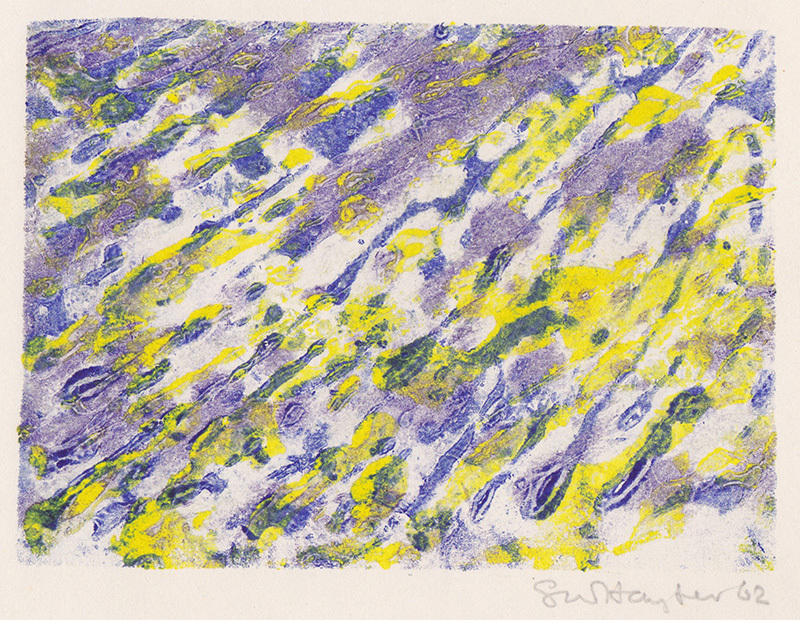
19th, 20th & 21st Century Fine Prints
707-546-7352 · fax 707-546-7924 · web: www.annexgalleries.com · email: artannex@aol.com
Greeting Card for 1962-63 by Stanley William Hayter

Greeting Card for 1962-63
Stanley William Hayter
Greeting Card for 1962-63
Stanley William Hayter
1901 - 1988 (biography)Atelier 17 founder Stanley William Hayter began doing his annual Greeting cards in 1930-31, often featuring techniques he was currently experimenting with - a peek into the future. Early cards were done in editions of 50, later in editions of 100. He did his last one in 1981-82 in a single impression. These original prints were pencil signed and dated. Given to colleagues, collectors, dealers, etc as a holiday gift many have personal annotations.
Hayter puts the universal laws of motion and change into a visual possibility. His colors got brighter and more electric, even fluorescent and moved in crisscrossing, rhythmic movement. This image, done for 1962-63, used three color linoleum blocks, printed and transferred to another plate and printed offset in three colors in an edition of around 100 impressions. The artist transferred the inked blocks to a metal plate and offset printed the inked plates to the paper.
This impression is from the estate of Atelier 17 printmakers and close friends, Fred Becker and Jean Morrison.
Stanley William Hayter was born in Hackney, England on December 27, 1901, to a family of artists. Though always interested in art, he began his adult life as a chemist and scientist. After working in the oil fields of Iran for three years, he went to Paris in 1926 to study at the Académie Julian. There he met the engraver Joseph Hecht and began to merge his early training in chemistry with a new found interest in printmaking.
Hayter spent most of his life in Paris where, in 1927, he founded an experimental workshop for the graphic arts, Atelier 17, that played a central role in the twentieth century revival of the print as an independent art form. The name Atelier 17 was adopted in 1933 when Hayter moved his establishment from its original home to 17 Rue Campagne Première. Through the late 1920s and into the 1930s he began a series of experiments using engraving, soft-ground etching, gaffrauge, open-bite, scorper and other innovative, textural techniques, all loosely based on the Surrealist/Jungian concepts of subconscious image and automatic line (Automatism). Artists from around the world gathered to work with him and ideas flowed freely. Hayter and most of the artists left Paris in late 1939 as war closed in on the city.
In 1940 Hayter moved to New York and re-founded Atelier 17 at the New School, moving to a studio on East 8 Street in 1945. The studio again became a melting pot for the artists who had arrived from Europe, American artists (many who had been part of the printmaking section of the WPA), and some young rebels (interested in breaking with the past and experimenting with technique and ideas). The emphasis in New York focused more on experimental color printing, including the use of viscosity printing and offset color using screenprint, stencil and woodcut. As in Paris, the salability of the image was near the bottom of the list of expectations.
Hayter returned to Paris in 1950 and re-established Atelier 17, attracting more international artists, many now coming from Asia. He continued to experiment with color printing, including the use of Flowmaster pens, incongruous and fluorescent colors and flowing, interwoven patterns. With an unrivaled knowledge of the technicalities of printmaking, Hayter authored two major books, 'New Ways of Gravure' (1949) and 'About Prints' (1962).
